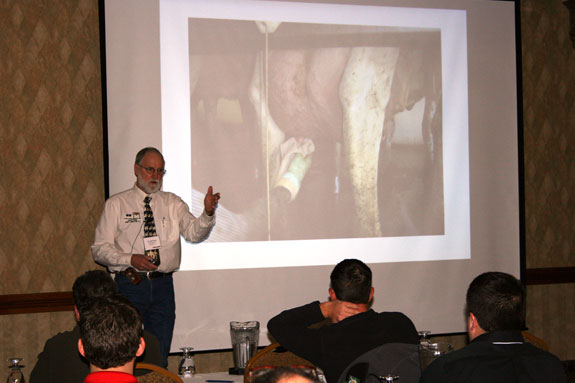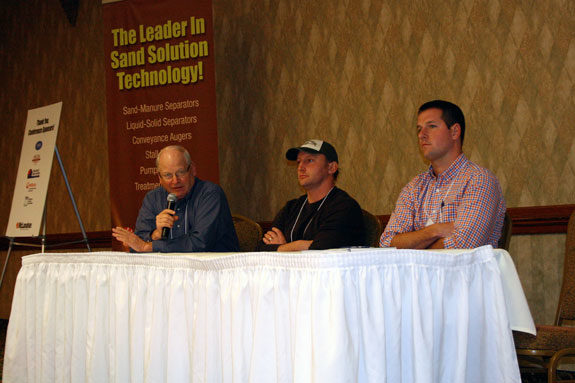When the Sand Solutions Conference began several years ago, a large focus was on the benefits of using sand for bedding. Since then, the message has been heard by the dairy industry and this year’s conference offered by McLanahan Agricultural Systems focused on the cows’ environment, cleanliness and comfort, as well as maximum sand recovery from recycling systems.
The two-day conference held in Madison, Wisconsin, Nov. 14 and 15, began with tours of area dairy farms.
Sand separation systems were explored at Dutch-Made Holsteins in Lake Geneva, Prairieland Dairy in Belleville and Larson Acres in Evansville. The second day involved a series of presentations.

Abiding by his No. 1 rule to “always do what is best for the cows,” Dr. David Reid of Rocky Ridge Dairy Consulting, LLC, said that while sand bedding can be very beneficial, it also has its challenges.
The use of sand bedding alone does not cure all milk quality problems on the dairy; it still needs to be managed well.
Teats and udders need to be properly cleaned to keep sand from getting in the liner of the milking machine, Reid emphasized. He also recommended removing hair from the cows’ udders, building stalls correctly, and keeping the stalls and barn clean.
“Sand is always better than the alternatives,” he said, “but you’ve got to manage it.”
Andrew Wedel, general manager of McLanahan Corporation’s Agricultural Systems Division, said in his presentation that the key to a successful sand recovery system is to design a sand system instead of a manure system.
A dairy with sand bedding uses an average of 50 to 60 pounds of sand per cow per day. For a 1,000-cow dairy keeping 60 days worth of $12 per ton sand, setting up a sand recovery system could yield $18,000 that could be used elsewhere on the farm, Wedel said.
He continued by explaining various options for sand-manure separation systems, the importance of water quality and sand type, how conveyance impacts the separation system and how to maximize sand recovery.
Bob Komro with Komro Sales & Service, Inc. has been designing and constructing sand recovery systems on farms for the last several years. The most popular system he’s built thus far is the flush flume, closed loop system.
Komro also emphasized the importance of water quality as cleaner wash water yields cleaner sand. The closed loop system allows the operator to control the elements and variables in the recovery process.
The flush flume is popular because it is “a simple way to move sand laden manure,” he said. However, the topography of the dairy is a deciding factor on if it would work for that particular farm.
Three dairy producers who have installed flush flume closed loop systems shared how it has helped their dairy.
Dean Doornink, Jon-De Farms in Baldwin, Wisconsin, converted from a labor-intensive skid-steer scrapping system to an automated floor scraper/flush flume concept for manure handling.
This new system meant the dairy could use recycled sand throughout the year instead of stockpiling it through the winter. It has also greatly reduced the number of maintenance calls Doornink would receive. “It has exceeded my expectations for management,” he said.
When Riverview LLP assumed ownership of Marshall Dairy in Veblen, South Dakota, the new owners recognized the sand separation system was using a tremendous amount of fresh water (30 gallons per cow) to make the sand settle out. It was also reclaiming only 60 percent of the sand and the quality of it was poor at best.
Lyle Grimm with Riverview LLP said the new system has cut fresh water inputs by two-thirds and cleaner water collected from feed pad runoff instead of the parlor water has increased the cleanliness of the sand. The dairy is also reclaiming 99.5 percent of its sand. “We thought we’d lose 2 to 3 percent, so that’s better than expected,” Grimm said.
Daley Farms in Lewiston, Minnesota, converted from mattresses and sawdust to sand bedding four years ago. Because the farm site is flat it was designed to vacuum tank transfer manure to the lagoon. The goal of a new system was to eliminate sand in the lagoon, but still allow for vacuum tank delivery.
Ben Daley reported the farm has reduced purchased sand from 1,200 loads per year to just 24 loads. A new vibrating sand dryer removes added moisture from the sand, which has also cut back sand storage time on the farm from 14 days to five days, reducing inventory by 65 percent.
In another presentation, Adam Onan, dairy manager, Central Sands Dairy, LLC shared how this central Wisconsin dairy keeps sand bedding out of its anaerobic digester. Sand-laden manure is picked up with vacuum tanks and delivered to the digester building.
There an auger, weir wall, hydro cyclone and sand lane remove sand before the manure enters the digester. To date, the digester has only been cleaned out once and Onan attributed that more to an experiment with digesting corn silage than sand buildup.
On the subject of cleaning out digesters, Charles Daniels, project manager for Veolia Environmental Services, told the audience about the precautions his team uses to work in these and other confined spaces. As trained first responders, his crew takes every possible safety measure into account when performing this dangerous task.
Now that sand has its foothold in the dairy industry, the focus now shifts on how to best work with it to achieve maximum results. PD
PHOTOS
TOP RIGHT: Dairy producers, left to right, Dean Doornink, Jon-De Farms; Ben Daley, Daley Farms; and Lyle Grimm, Riverview LLP; shared how revamped sand recovery systems on their farms are performing.
MIDDLE RIGHT: Dr. David Reid of Rocky Ridge Dairy Consulting, LLC, explained how important it is to thoroughly remove sand from the teat surface in preparation for milking. Photos by PD Editor Karen Lee.

Karen Lee
Editor
Progressive Dairyman magazine





